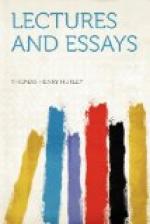Under these circumstances, it may be imagined that the establishment of a scientific frontier between the earlier realm of supposed fact and the later of asserted delusion, had its difficulties; and torrents of theological special pleading about the subject flowed from clerical pens; until that learned and acute Anglican divine, Conyers Middleton, in his “Free Inquiry,” tore the sophistical web they had laboriously woven to pieces, and demonstrated that the miracles of the patristic age, early and late, must stand or fall together, inasmuch as the evidence for the later is just as good as the evidence for the earlier wonders. If the one set are certified by contemporaneous witnesses of high repute, so are the other; and, in point of probability, there is not a pin to choose between the two. That is the solid and irrefragable result of Middleton’s contribution to the subject. But the Free Inquirer’s freedom had its limits; and he draws a sharp line of demarcation between the patristic and the New Testament miracles—on the professed ground that the accounts of the latter, being inspired, are out of the reach of criticism.
A century later, the question was taken up by another divine, Middleton’s equal in learning and acuteness, and far his superior in subtlety and dialectic skill; who, though an Anglican, scorned the name of Protestant; and, while yet a Churchman, made it his business, to parade, with infinite skill, the utter hollowness of the arguments of those of his brother Churchmen who dreamed that they could be both Anglicans and Protestants. The argument of the “Essay on the Miracles recorded in the Ecclesiastical History of the Early Ages” [60] by the present [1889] Roman Cardinal, but then Anglican Doctor, John Henry Newman, is compendiously stated by himself in the following passage:—
If the miracles of Church
history cannot be defended by the
arguments of Leslie,
Lyttelton, Paley, or Douglas, how many of the
Scripture miracles satisfy
their conditions? (P. cvii.)
And, although the answer is not given in so many words, little doubt is left on the mind of the reader, that in the mind of the writer, it is: None. In fact, this conclusion is one which cannot be resisted, if the argument in favour of the Scripture miracles is based upon that which laymen, whether lawyers, or men of science, or historians, or ordinary men of affairs, call evidence. But there is something really impressive in the magnificent contempt with which, at times, Dr. Newman sweeps aside alike those who offer and those who demand such evidence.




